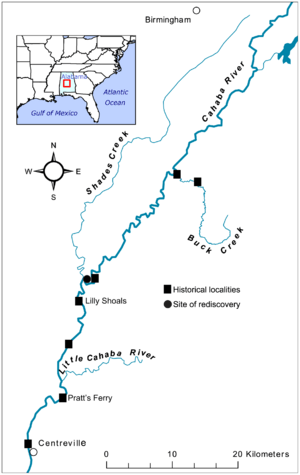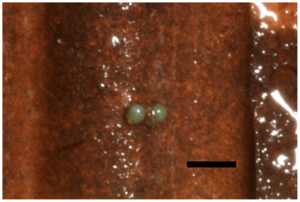Oblong rocksnail facts for kids
Quick facts for kids Oblong rocksnail |
|
|---|---|
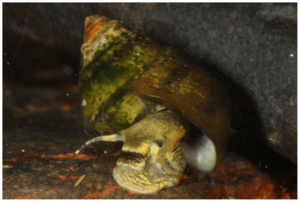 |
|
| A live individual of Leptoxis compacta | |
| Scientific classification | |
| Genus: |
Leptoxis
|
| Species: |
compacta
|
| Synonyms | |
|
Melania compacta Anthony, 1854 |
|
The oblong rocksnail, also known as Leptoxis compacta, is a type of freshwater snail. It's an aquatic gastropod mollusk (like a clam or octopus) that lives in water and has a special "trapdoor" called an operculum to close its shell. It belongs to the snail family Pleuroceridae.
This snail only lives in the Cahaba River in Alabama, United States. For a long time, people thought it was extinct (meaning it had completely died out). It hadn't been seen since 1933 and was officially declared extinct in 2000. However, in 2011, it was excitingly rediscovered in a small part of the Cahaba River! Scientists published a formal report about its rediscovery in August 2012.
Scientists are now studying its genetics to understand its family tree better.
Where the Oblong Rocksnail Lives
Today, the Leptoxis compacta is found in only one spot in the Cahaba River. This special place is an unnamed shoal (a shallow area in a river) located upstream from where the Cahaba River meets Shades Creek in Shelby County, Alabama.
In the past, the oblong rocksnail was most common in the middle part of the Cahaba River, especially at Lily Shoals in Bibb County, Alabama. Its historical home stretched from Centerville upriver into the lower part of Buck Creek. This area is part of the southern Appalachian Mountains.
Scientists aren't completely sure why the number of oblong rocksnail decreased so much. However, they know the snail's population and living area were shrinking by 1935. It's thought that its naturally small living range and pollution from mines and the Birmingham, Alabama area contributed to its decline.
This snail was the only type of pleurocerid snail living in the Cahaba River that was believed to be extinct. It hadn't been found in river surveys done in 1992, 2005, and 2008.
Because this snail lives in such a small area, it's very vulnerable to a single big event that could wipe it out. This means it needs immediate help to protect it. One idea to save the species is to raise them in special facilities and then release them back into the river. This could help prevent them from becoming extinct again.
What the Oblong Rocksnail Looks Like
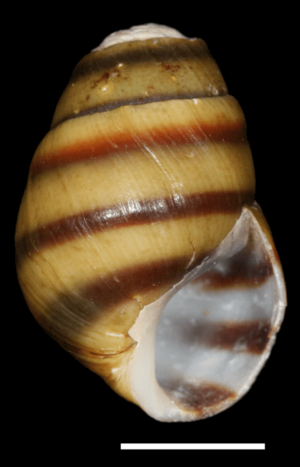
The oblong rocksnail was first described by an American scientist named John Gould Anthony in 1854.
The snail's shell is oval-shaped, smooth, thick, and yellowish-green. The top part of the shell, called the spire, is slightly raised. The shell has about five whorls (the turns of the spiral), which are almost flat. The largest and lowest whorl, called the body whorl, is slightly angled near the bottom. It has three very dark bands, with two of them below the angle. The whorl just before the body whorl has only two bands. The lowest band on this whorl is almost hidden by the suture (the line where the whorls join). On the top whorl, this same band looks like a dark, thin line. The sutures are clearly visible.
The opening of the shell, called the aperture, is quite large and oval-shaped. Inside, it is whitish and also has bands. The central pillar of the shell, called the columella, has a strong indentation. The base of the shell is smoothly rounded, without any notch.
- The shell is about 10 mm wide.
- The shell is about 15 mm tall.
- The aperture is about 7.5 mm tall.
Most snails found in the wild in 2011 had purple coloring on the columella's indentation. However, young snails raised in captivity did not have this purple color. The outside of the snail's body is yellow with black spots. It also has clear black bands in the middle of its proboscis (a snout-like part) and around both of its eyes. This pattern of black bands is the same as another snail called Leptoxis ampla, which lives in the same area. The patterns on their bodies and the presence of an "ocular peduncle" (a stalk that holds the eye) help tell Leptoxis compacta apart from other similar snails like Elimia clara.
Young Leptoxis compacta shells have a distinct ridge, called a carina, on their main body whorl. This ridge disappears as the snails grow into adults.
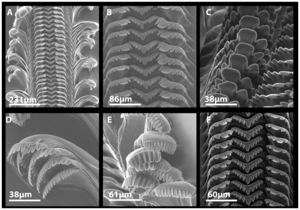
The radula of Leptoxis compacta has a central tooth with a wide, curved base and a blunt main point. This main point is surrounded by four to five smaller tooth-like parts called denticles. The side teeth have one larger rectangular main point, with four to five outer denticles and three to four inner denticles. The inner teeth along the edge have 10 to 12 denticles, and the outer edge teeth have 12 to 16 denticles. The outer denticles are often not very strong.
Ecology and Reproduction
The Leptoxis compacta lives in shallow, rocky areas of rivers called shoals.
Scientists watched about 30 L. compacta snails collected in 2011 and kept in captivity to learn about their reproduction. Female snails laid their eggs either one by one or in short, single lines. Each egg was about 0.3 mm wide. On average, a line of eggs was about 1.57 eggs long, with the longest observed line having 3 eggs.


